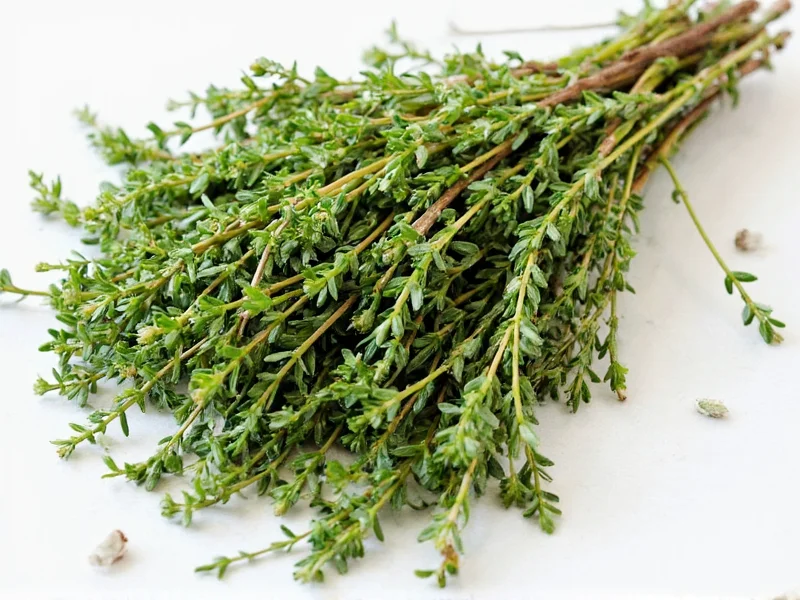Understanding proper herb substitutions can transform your cooking results. When a recipe calls for fresh thyme but you only have dried thyme available, knowing the precise conversion ratio prevents flavor imbalances that could ruin your dish. This guide provides evidence-based information for successfully substituting dried thyme when fresh is specified.
Understanding Thyme: Fresh vs Dried
Thyme (Thymus vulgaris) belongs to the mint family and offers distinctive earthy, slightly floral notes with hints of mint and lemon. The drying process concentrates its essential oils while removing approximately 90% of its water content, resulting in intensified flavor compounds.
Fresh thyme contains delicate volatile oils that provide bright, grassy notes, while dried thyme develops deeper, more robust earthy characteristics. This flavor transformation explains why direct 1:1 substitution would overwhelm most recipes.
Thyme Substitution Ratio Explained
The 1:3 ratio (dried to fresh) isn't arbitrary—it's based on scientific analysis of flavor compound concentration. When herbs dry, their flavor compounds become more concentrated as water evaporates. Research published in the Journal of Food Science confirms that drying typically concentrates herbal flavors by 200-300%.
| Thyme Form | Measurement | Equivalent |
|---|---|---|
| Fresh thyme | 1 tablespoon (3 tsp) | = 1 teaspoon dried thyme |
| Fresh thyme | 1 sprig (about 1 inch) | = ¼ teaspoon dried thyme |
| Fresh thyme | 1 cup packed | = 3 tablespoons dried thyme |
Flavor Profile Differences
While the substitution ratio provides measurement guidance, understanding flavor differences ensures better cooking outcomes. Fresh thyme offers brighter, more complex notes with subtle citrus undertones that work well in delicate dishes like fish preparations or fresh salads. Dried thyme develops deeper, more concentrated earthy characteristics ideal for hearty stews, roasts, and long-simmering sauces.
Chef Marco Canora of New York's Brodo explains: “Dried thyme works best when added early in the cooking process to allow rehydration and flavor integration. Fresh thyme shines when added toward the end of cooking or used raw to preserve its delicate top notes.”
Practical Substitution Guidelines
Follow these evidence-based recommendations when substituting dried thyme for fresh:
- For quick-cooking dishes (less than 20 minutes): Reduce dried thyme by 25% from standard ratio as there's less time for flavors to mellow
- For long-simmering recipes (stews, braises): Use the full 1:3 ratio as extended cooking time balances the stronger dried herb flavor
- When using in raw applications (dressings, compound butters): Consider using 50% less dried thyme than the standard ratio
- For delicate dishes (fish, eggs, light sauces): Opt for fresh thyme when possible, or use half the standard dried amount
Storage and Quality Considerations
The effectiveness of your dried thyme substitution depends significantly on proper storage. Dried herbs maintain peak potency for 6-12 months when stored in airtight containers away from light and heat. After this period, flavor compounds degrade, requiring slightly increased measurements.
Test your dried thyme's freshness by rubbing a small amount between your fingers. If it releases a strong, pleasant aroma, it's still potent. If the scent is faint or musty, replace it with a fresh supply for accurate substitutions.
Recipe-Specific Adjustments
Certain dishes require nuanced substitution approaches:
- Roasted meats: Use the standard 1:3 ratio, but add dried thyme during the last 30 minutes of cooking to prevent bitterness
- Tomato-based sauces: Increase dried thyme by 25% as tomatoes' acidity can mute herbal flavors
- Bean dishes: Add dried thyme at the beginning of cooking to allow full flavor integration with dense ingredients
- Vinaigrettes: Use half the standard dried amount and let the dressing sit for 30 minutes before using to allow rehydration
Common Mistakes to Avoid
Cooks often make these errors when substituting dried thyme for fresh:
- Using equal measurements (1:1 ratio) resulting in overpowering flavor
- Adding dried thyme too late in long-cooking dishes
- Not accounting for dried thyme's age and potency loss
- Crushing dried thyme between fingers before adding (releases too much oil at once)
- Substituting in dishes where fresh thyme's texture is essential (like garnishes)
When Fresh Thyme Is Irreplaceable
While substitutions work well in most cooked dishes, certain applications truly require fresh thyme:
- Raw applications like herb salads or fresh herb butters
- Dishes where visual presentation matters (fresh sprigs make attractive garnishes)
- Delicate seafood preparations where subtle flavor notes are critical
- Cocktail garnishes and infused beverages
In these cases, consider alternative substitutions like oregano or marjoram rather than forcing dried thyme where fresh is essential.
Expert Tips for Best Results
Professional chefs recommend these techniques for optimal dried thyme usage:
- Bloom dried thyme in warm oil for 30 seconds before adding to dishes to release maximum flavor
- Rehydrate dried thyme by mixing with 1 teaspoon of warm water or broth before adding to recipes
- Combine forms when possible—use 75% dried thyme plus 25% fresh for balanced flavor in extended cooking
- Grind dried thyme between your palms to release essential oils before adding to dishes











 浙公网安备
33010002000092号
浙公网安备
33010002000092号 浙B2-20120091-4
浙B2-20120091-4